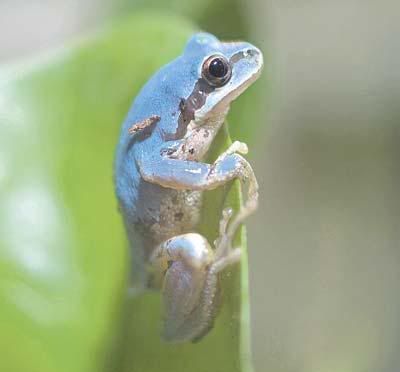Blue Frog
I searched for this in the tags and didn't find anything about it, so I hope it's not a repost.
I found this really interesting article in our local paper about a tree frog someone had found with a rare mutation that made it bright blue instead of green.

Eureka frog has the blues
The Times-Standard
Article Launched: 06/10/2008 01:15:47 AM PDT
If you're a Pacific tree frog, being blue just isn't normal.
But one of these unusual azure amphibians turned up in Eureka resident Linda Lange's garden recently, and she recognized it as anything but typical. She called the Humboldt State University Natural History Museum.
Tree frogs, also called Pacific chorus frogs, are almost invariably green. Humboldt State University herpetologist Sharyn Marks said a blue one has never been reported, probably because most that are born blue would stick out and get eaten.
The coloration makes it look like the highly toxic species from Suriname, the blue poison frog. The problem is, the Eureka tree frog isn't poisonous.
”Unlike green or brown frogs, which typically blend in pretty well with their surroundings, blue frogs stand out like a sore thumb. For the toxic blue poison frogs, this isn't a problem, but for your typical Pacific chorus frog, which isn't toxic, blue coloration is a distinct disadvantage,” Marks adds.
Researchers said that the tree frog's typical green is cause by yellow pigment over gray cells, which makes them look green. But when the yellow pigment is missing because of a genetic mutation, it looks blue.
After seeing the frog, Marks said, “Wow, that's just a gorgeous animal. I think humans like blue and there aren't a lot of blue animals in nature. We tend to react strongly to blue, so my eyes said, 'yum.'”
The Natural History Museum decided to take the frog in and put it on display.
June 6 marks the opening of the museum's latest exhibit, Animals of the North Coast. Many creatures, including the blue tree frog, will be on display during the museum's regular hours, Tuesday through Saturday, 10 a.m. to 5 p.m. The museum is located at 1315 G Street in Arcata, CA and admission is $3 adults, $2 children.
I found this really interesting article in our local paper about a tree frog someone had found with a rare mutation that made it bright blue instead of green.

Eureka frog has the blues
The Times-Standard
Article Launched: 06/10/2008 01:15:47 AM PDT
If you're a Pacific tree frog, being blue just isn't normal.
But one of these unusual azure amphibians turned up in Eureka resident Linda Lange's garden recently, and she recognized it as anything but typical. She called the Humboldt State University Natural History Museum.
Tree frogs, also called Pacific chorus frogs, are almost invariably green. Humboldt State University herpetologist Sharyn Marks said a blue one has never been reported, probably because most that are born blue would stick out and get eaten.
The coloration makes it look like the highly toxic species from Suriname, the blue poison frog. The problem is, the Eureka tree frog isn't poisonous.
”Unlike green or brown frogs, which typically blend in pretty well with their surroundings, blue frogs stand out like a sore thumb. For the toxic blue poison frogs, this isn't a problem, but for your typical Pacific chorus frog, which isn't toxic, blue coloration is a distinct disadvantage,” Marks adds.
Researchers said that the tree frog's typical green is cause by yellow pigment over gray cells, which makes them look green. But when the yellow pigment is missing because of a genetic mutation, it looks blue.
After seeing the frog, Marks said, “Wow, that's just a gorgeous animal. I think humans like blue and there aren't a lot of blue animals in nature. We tend to react strongly to blue, so my eyes said, 'yum.'”
The Natural History Museum decided to take the frog in and put it on display.
June 6 marks the opening of the museum's latest exhibit, Animals of the North Coast. Many creatures, including the blue tree frog, will be on display during the museum's regular hours, Tuesday through Saturday, 10 a.m. to 5 p.m. The museum is located at 1315 G Street in Arcata, CA and admission is $3 adults, $2 children.